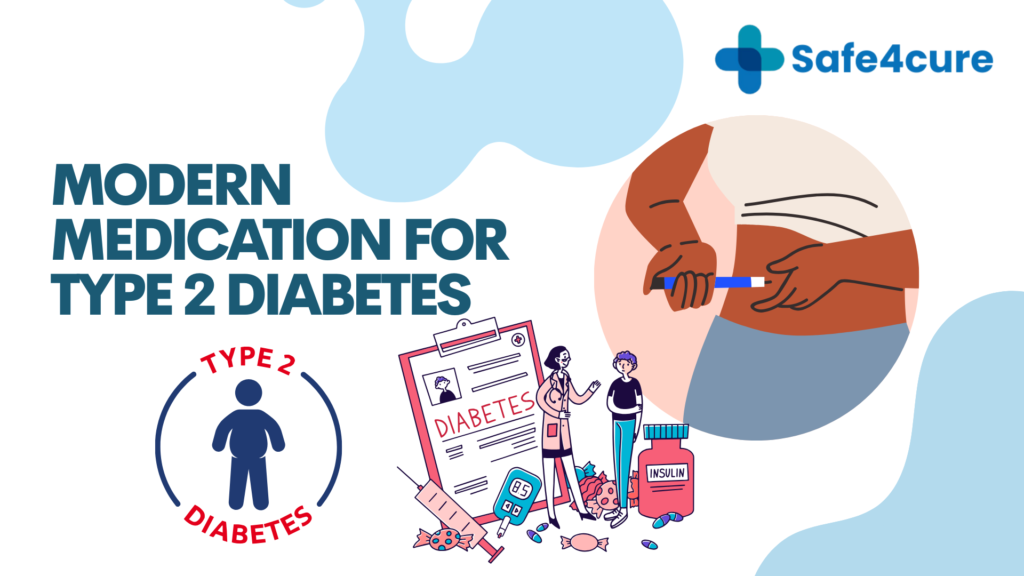Managing type 2 diabetes is not just about diet and exercise. For many people, taking the right medication for type 2 diabetes is essential to keep blood sugar levels in check and prevent complications. With new medicines emerging over the years, understanding what’s available and how each one works can help you make informed decisions with your healthcare provider.
This guide breaks down the best medication for type 2 diabetes, including oral and injectable medications for type 2 diabetes to give you a clear picture of your options.
What Is Type 2 Diabetes Mellitus?
Type 2 diabetes mellitus is a chronic condition where the body either doesn’t make enough insulin or can’t use it effectively. This leads to high blood sugar, which over time may cause problems with the heart, kidneys, eyes, and nerves.
Common Type 2 Diabetes Symptoms
- Increased thirst
- Frequent urination
- Tiredness or fatigue
- Blurred vision
- Slow healing wounds
Recognizing these early signs is crucial, as timely treatment can help manage the condition and avoid long-term complications.
Types of Medications for Type 2 Diabetes
Medications aim to keep blood sugar within a healthy range. Depending on your condition, your doctor may prescribe one or a combination of the following:
1. Oral Medications
These are usually the first choice when lifestyle changes alone are not enough.
- Metformin: Often the first-line treatment, it reduces glucose production in the liver and improves the body’s insulin sensitivity.
- Sulfonylureas: Help the pancreas release more insulin.
- DPP-4 Inhibitors: Slow down the breakdown of a natural compound that helps control blood sugar.
- SGLT2 Inhibitors: Help remove extra glucose from the body through urine.
2. Injectable Medications for Type 2 Diabetes
If oral medicines do not provide adequate control, doctors may recommend injectables. These can be more effective for some individuals, especially those with higher blood sugar levels.
GLP-1 Receptor Agonists
These medicines mimic a hormone called GLP-1 that helps lower blood sugar, slows digestion, and promotes weight loss. Examples include:
- Liraglutide
- Semaglutide
- Mounjaro (Tirzepatide) Injection – A newer option that also acts on another hormone, GIP, in addition to GLP-1.
Insulin
When the pancreas is unable to produce enough insulin, insulin injections are prescribed. Different types include:
- Rapid-acting
- Long-acting
- Premixed insulin
Spotlight on Mounjaro (Tirzepatide) Injection
One of the most talked-about new treatments is Mounjaro tirzepatide injection. This medication combines the effects of two hormones (GIP and GLP-1) to improve blood sugar control.
Key Benefits
- Helps reduce blood sugar levels effectively
- Can support weight loss in people with type 2 diabetes
- Taken as a once-weekly injection
Who Can Benefit?
- Adults with type 2 diabetes mellitus
- Individuals who have not reached their target blood sugar with oral medicines
- Those looking for an alternative to insulin in certain cases
It is currently available by prescription in countries like Australia, the United States, and the United Kingdom.
What Is the Best Medication for Type 2 Diabetes?
There is no single “best” option for everyone. The right medicine depends on:
- How high your blood sugar is
- Your weight and lifestyle
- Presence of other health issues (heart disease, kidney problems, etc.)
- Your doctor’s treatment plan
For some, metformin alone works well. For others, a combination of oral tablets and injectables such as Mounjaro tirzepatide may provide better results.
How to Choose the Right Medication
1. Work with Your Healthcare Provider
Never start or stop medicines without medical advice. Your doctor will recommend a plan based on your individual health needs.
2. Understand the Side Effects
Each medication has its own potential side effects. For example:
- Metformin may cause stomach upset initially.
- GLP-1 receptor agonists may cause nausea or vomiting in the beginning.
3. Focus on Lifestyle Alongside Medication
Even the best medication for type 2 diabetes works best when combined with:
- Healthy eating
- Regular physical activity
- Adequate sleep
- Stress management
Future of Type 2 Diabetes Management
Modern research continues to bring better medicines with fewer side effects and more benefits. Injectable medications for type 2 diabetes, like Mounjaro, are changing how people manage the condition, offering both blood sugar control and weight management.
In the future, more combination treatments and personalized therapies may help individuals maintain normal blood sugar levels without multiple daily doses.
Key Takeaways
- Medication for type 2 diabetes is often needed alongside lifestyle changes.
- Options include oral tablets, injectable medications for type 2 diabetes, and insulin.
- Mounjaro tirzepatide injection is a promising new treatment available in Australia, the USA, and the UK.
- The best medication for type 2 diabetes depends on individual health, response to treatment, and medical advice.
FAQs About Medications for Type 2 Diabetes
1. What is the best medication for type 2 diabetes?
There is no one-size-fits-all medication. The best treatment depends on your blood sugar levels, health status, and your doctor’s recommendation. Metformin is often the first-line choice, but injectables like Mounjaro tirzepatide are becoming popular for added benefits.
2. Are injectable medications for type 2 diabetes better than tablets?
Not always. Injectable medications such as GLP-1 receptor agonists can offer more effective blood sugar control for some people, especially when tablets alone are not enough.
3. Can Mounjaro tirzepatide be used as the first medication?
Usually, it is prescribed when other medications like metformin are not sufficient. Your doctor will decide if it’s right for you.
4. Are there side effects with injectable medications?
Yes, common side effects may include nausea, diarrhea, or loss of appetite in the beginning. These usually reduce over time as your body adjusts.
5. Is Mounjaro tirzepatide available in Australia, the US, and the UK?
Yes, it is approved for use in all three regions, but availability may vary depending on your local healthcare provider and prescription guidelines.

